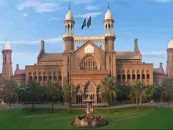Anti-colonial activism: ‘Ghadar movement struck terror in British hearts’
Two-day conference on radical politics in colonial, post-colonial South Asia begins.

Set in the backdrop of increasing discrimination against rural Indian labour in Canada and America, a shift from old European industrialism to a new transnational capitalism and artificially created famine-like conditions in India in the early 1900s, the Ghadar Movement emerged – inspired from the 1857 revolt – as a transnational front for anti-colonial activism.
Radical movements like Ghadar seem to have been forgotten in the rubric of South Asia’s national history. “But how can you forget something you have never known,” asks Anjum Altaf, former dean of School of Humanities and Social Sciences at the Lahore University of Management Sciences.
The two-day 10th Annual HSS Conference, Commemorating Ghadar: Radical Politics in Colonial and Post-Colonial South Asia, began at LUMS on Saturday.
Ali Usman Qasmi, one of the organisers of the conference, said the conference would have an educative value for the public most of whom have little knowledge of this important aspect of South Asian history.
Ghadar Movement was one of the first of a series of radical movements to have emerged in this region, Harish K Puri, Professor Emeritus at Guru Nanak Dev University, Amritsar, said in his keynote address.
This was the only time in history that thousands of migrant workers abroad returned to their homeland to liberate it from an imperial power. Freedom to them was the first step in creating a new social and political order. They had a romantic vision of an egalitarian society in which all kinds of difficulties resulting from poverty and neglect would be removed. The movement emerged primarily from rural Punjabi migrants. Most of them were illiterate and many dreamt of bringing their families to Canada and America. That went awry after Canadian and American governments clamped down on immigration and introduced discriminatory laws against the migrants.
The Ghadar weekly journal was the movement’s foremost front for action.
Lala Har Diyal, the editor for the publication, used simple language in order to reach out to the peasant classes.
“It was the language of logic – aqal diyan gallaan – that would touch the peasant’s heart.” The first issue of Ghadar in 1913 announced: today there begins in foreign lands but in the language of the country, a war against the English rulers, nothing less than a war.
When World War 1 broke out, the Ghadarites believed that was the time for Indians to rise against their colonial masters.
Puri spoke of how the Ghadar Movement had sparked terror in the hearts of the British. So much so that that the then home secretary of India Sir James Houssemayne Du Boulay told activist Gobind Behari Lal that the Jallianwala Bagh massacre in Amritsar could be traced to the Ghadar Movement.
Lal said, “The British took us seriously… so seriously that they blew our heads off.”
However, the Ghadar Movement’s active revolution tends to overshadow quieter forms of anti-colonial agitation, James Daniel Elam, a scholar at Northwestern University, argued.
Elam’s work looks at the cultivation of a “readerly sensibility” that was central in creating the basis for an anti-colonial self-culture. He discussed the aesthetic and philosophical aspects of the movement which stressed the centrality of reading as an act of revolution.
Elam began with Macaulay’s famous quote: We must at present do our best to form a class who may be interpreters between us and the millions whom we govern; a class of persons, Indian in blood and colour, but English in taste, in opinions, in morals, and in intellect.
The Ghadar Movement stood in opposition to the project to anglicise Indians by creating a collective anti-colonial imagination.
Juxtaposing liberal and radical anti-colonial movements represented by Gandhi in South Africa and Ghadar, Radha D’Souza, from the University of Westminster, spoke of the similarities in their political and material conditions and the differences in their approach towards the British. She pointed towards the difference in socio-economic class as a reason for their differences.
She quoted Gandhi as saying: The English-speaking Indians came to the conclusion that they would offer their services unconditionally, without payment, to the British in any capacity to show the worthy colonists that they were worthy subjects of the Queen. It was the Indians’ proudest boast that they were British subjects – if they weren’t they would not have footing in South Africa.
These are the first 20 years of the 1900 and the Ghadarites and Gandhi were writing around the same time in the same political environs. In contrast, the Gadharites’ account went something like this: The tyrants call us coolies; talk ill of us; we don’t have any dignity left; the tyrant snatched away our covering. The Gadharites were entirely different in that their journey was home-ward to overthrow the tyrant.
“We are at a turning point in history, in which most third world countries are racked with war and violence waged at the behest of imperial powers. We, today, need to look at lessons from the Ghadar Movement and tell the world how it’s done,” D’Souza said.
Published in The Express Tribune, December 7th, 2014.



















COMMENTS
Comments are moderated and generally will be posted if they are on-topic and not abusive.
For more information, please see our Comments FAQ